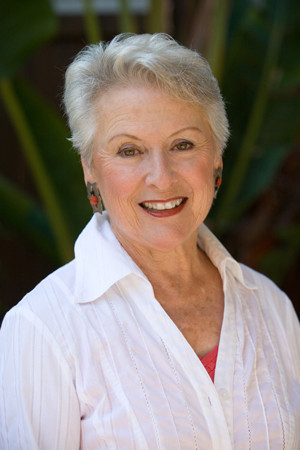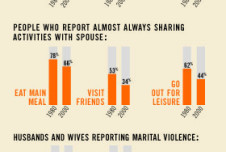Of all the changes the American family has experienced over the past two generations, perhaps none is more widely discussed and debated than the rise of divorce. By now, the story is well-known: Divorce rates in the United States climbed drastically throughout the 1960s until the early ’80s; though they’ve declined a bit since then, nearly half of all marriages will still end in divorce.
In 1994, after three decades of debate had started to crystallize around a basic set of presumptions about divorce, sociologist Constance Ahrons published a book that shattered these presumptions and recast the debate.
 © Kevin Walsh
© Kevin Walsh
Based on multiple in-depth interviews with 98 ex-spouses, all of whom had children, The Good Divorce argued neither for nor against divorce; instead, it took divorce as a fact of contemporary American life and drew distinctions between “good” and “bad” kinds of divorce. Ahrons challenged the assumption that divorced parents and their children are damaged goods, and she highlighted the ways by which divorcing parents could preserve their own and their children’s wellbeing. Three years ago, Ahrons published a sequel, We’re Still Family, for which she interviewed 173 children of those original couples, revealing what these now-adult children saw as the keys to the positive and negative developments in their family since their parents’ divorces 20 years earlier.
Though she has retired as a professor at the University of Southern California, Ahrons remains active in public debates around divorce, lecturing widely and serving as a senior scholar for the nonprofit Council on Contemporary Families. She recently spoke with Greater Good about how the divorce debate—and the prospects for “binuclear families,” a term she coined—have and haven’t changed in the almost 30 years since she began her research.
Greater Good: What are the defining features of a good divorce?
Constance Ahrons: The major principle of a good divorce is that the divorce doesn’t destroy children’s family bonds and relationships. Children need stable relationships within the family, and they want to have time with both parents. By maintaining relationships with both parents, they are also less likely to experience disruptions in relationships with their extended family— their grandparents, aunts, uncles.
It’s a simple formula, but one that’s very difficult and somewhat paradoxical. Although people are ending their marital relationship, they need to continue relating as parents. It’s a terribly ambiguous and stressful time when they need to figure out how to divide things up. Anger escalates, and it’s emotionally difficult to remember the positives of their relationship.
GG: There’s a lot of resistance to that basic concept of the “good divorce.” Critics like Elizabeth Marcourt claim that there’s no such thing as a good divorce. Marcourt, for instance, has written, “Any kind of divorce, whether amicable or not, sows lasting inner conflict in children’s lives.”
CA: On the first page of the Introduction to The Good Divorce, I ask the question, “Is divorce good?” And then I answer the question: It’s a resounding “No.” The next question I address is, “If divorce isn’t good, is there such a thing as a good divorce?” and the answer to that is a resounding “Yes.”
The point is that some divorces are better than others: The conflict is contained, the children’s needs are paramount, and the children continue to have relationships with both parents.
The notion of a good divorce seems to be impossible for many people to come to accept—the concept is so misunderstood. On my book tour, I went around the country appearing on early morning television interviews, and I was amazed that about half of the hosts felt that I was promoting divorce. They were furious with me. The basic fear seems to be that if there is such a thing as a good divorce, then everyone’s going to run out and get a divorce tomorrow.
GG: Yet you and conservative critics of divorce still share a primary goal: the wellbeing of children whose parents divorce. But you have very different opinions about what can be done to achieve that goal—they focus on preventing divorce, or at least curtailing it, whereas you concentrate on mitigating its negative effects. Why do you think you’ve taken a different approach from them?
CA: I’ve thought a lot about that. On a personal level, I had been through a divorce in a very difficult time—before joint custody was an option, before “no-fault” legislation—and I saw the real negatives of the system. I saw how it escalated the anger between my children’s father and myself, which took years for us to undo. Viewing it from the inside, I felt like, “There has got to be some better way than this.”
But I think my views are also influenced by the fact that I’m a sociologist and a psychologist, I’m a researcher and a therapist. I see divorce as a fact of contemporary family life, and it’s obvious that a sizeable proportion of the adult population is going to have more than one marriage or serious cohabitation in their lifetime.
GG: So from a sociological perspective, why do you see divorce as a fact of life that we have to adapt to rather than eliminate?
CA: Well, there are many factors. One major reason is the increased economic independence of women: Women can now choose to leave marriages that they couldn’t afford to leave 50 years ago. And, in fact, the majority of divorces in the U.S. and other countries are initiated by women. In China, for example, the divorce rates in the cities have skyrocketed in recent years. Women there have told me that now that they have good jobs and their own income, they no longer need to accept the “bad” behavior of their husbands.
Another important factor is longevity. One of the newer issues we’re confronting is the increased rates of the “graying divorce.” Why is it that more people are getting divorced after their kids are grown, after 30 or more years of marriage, when they’re in their 60s and even their 70s? Well, a woman in her late 60s or early 70s is likely to live for 20 more years, and after years of living in an unhappy marriage, she decides she wants to enjoy what’s left of her life.
Also, we can’t forget that we are a culture that focuses on the self, individual rights, happiness. The modern view of marriage is based on love, and we search for our soul mate. But marriages based on romantic love alone are fragile; when love wanes, divorce becomes a viable option.
GG: Since people will continue to divorce, does your research suggest some practical and effective strategies to help them have a good divorce?
CA: In my research, when grown children were interviewed 20 years after their parents’ divorce, they were clear about what worked for them, and what didn’t. Their winning formula was parents who were supportive, who didn’t involve the kids in their conflicts, stayed involved in their lives, respected each other’s rights as parents, and provided a stable and secure family environment. That’s a tall order for divorcing parents! My interviews with their parents over the first five years after the divorce showed that some parents, however, managed to do it. For the most part, they contained their anger, put their children’s needs first, and developed a fairly cooperative coparenting relationship.
Another important factor was that they didn’t engage in a drawn-out adversarial battle. It takes some maturity on the part of parents to exercise self-control and put their children’s needs ahead of their own.
In addition to what parents themselves can do, I think some societal changes have also helped. No-fault legislation, which has been in place now for over 30 years, has been key in helping parents reduce or at least not escalate their anger. No-fault is not without its problems. But at least in the courts now, it is not necessary to charge blame in order to get a divorce. When I divorced in 1966, it was a fault-based system. The reasons for divorce had to be something like adultery or “cruel and inhuman treatment.” In my case, I had to define cruel and inhuman treatment to the judge (with coaching from my lawyer) by exaggerating minor things, such as disagreements over parenting and him working long hours. Those charges created more anger that took us years to overcome.
Also, mediation has grown in popularity and is now mandated in many court systems around the country. In those cases, couples cannot litigate prior to trying to resolve their differences through mediation, which in general encourages a spirit of compromise.
And collaborative divorce is the newest kid on the block. It’s a team approach that is not set up on a win-lose basis and involves several professionals—two lawyers, a mental health professional coach for each parent, a child specialist for the children, and perhaps
a financial specialist as well. The parents are expected, with the help of the team, to settle their financial issues and devise a parenting plan that spells out how much time children will spend with each parent, and who’s responsible for what.
GG: Can policy makers have a positive influence? What public policies could help make good divorces more common?
CA: We have no policies that are geared toward strengthening binuclear families. We have nothing in place to help children come to terms with their new lives, with living in more than one household, with coping with their parents’ conflicts.
Parents need programs to help them learn how to have a good divorce, how to be civil with one another, how to parent effectively across households, how to resolve conflict. Although there are individual programs here and there, we need public funds to make these programs available to all kids whose parents divorce. More and more courts are mandating education programs for parents, but they tend to be brief and there is not sufficient funding to really make these programs effective.
More funding is sorely needed for early intervention programs that are aimed at reducing conflict between divorcing parents, helping fathers stay more involved with their children, and involving grandparents and other extended family members.
GG: So what are some of your results that suggest a good divorce is truly possible?
CA: The research is clear now that the majority of children whose parents divorce grow up to be well-functioning adults. Even when parents are unable to have a good divorce, many children manage to thrive.
One surprising finding has been that even in the worst situations, some children came through it without long-term damage. By looking at siblings in a family, I could hone in on the individual differences in adjustment and what they might be related to. For example, in a family with three children, why was one child doing well and the other two were having major problems? Of course there are individual differences in temperament, etc. But one factor that kept showing up over and over again was that the child who was doing well had a grandparent, teacher, coach, or someone else who they felt close to.
Another factor was that the child who was thriving was very involved in a particular sport, church activity, or academics. One child said, “If I didn’t have my swimming practice every day, I don’t know how I would have survived.” Some kids found ways to feel better about themselves outside of their family when things were going badly within their family. These children were more resilient than their siblings.
It also came as a surprise to me that so many of the grown children now felt that their parents’ decision to divorce was the right decision. They were able to process it more in adulthood, and they felt that they were better off and that their parents were better off. This was about 75-78 percent of the kids who spoke about these kinds of feelings.
It’s from the families in which kids do not have long-term negative consequences that we can learn what factors help children survive and even thrive after divorce. Because the bad divorces get so much more exposure we think of them as the norm, but in fact they are not.
I don’t think I could have possibly stayed in this field as long as I have, which is much longer than I intended to, if I wasn’t optimistic that we could see positive changes. I get discouraged frequently, but I have an underlying optimism that there is a better way.




Comments